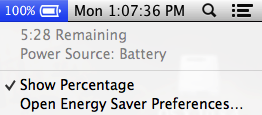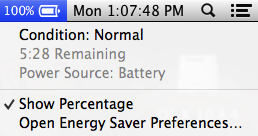Use the following links to navigate to your area of interest in this article.
Understanding batteries in Mac notebooks
Optimizing battery life
Troubleshooting batteries
Servicing the battery in your Mac notebook
Understanding batteries in Mac notebooks
Terms and definitions
MacBook, MacBook Air, and MacBook Pro computers come with lithium polymer batteries to provide maximum battery life in a compact space. In order to fully understand battery technology and battery life, it's good to know common battery terminology.
- Cycle count: Batteries are expected to function for a certain number of Cycles. This number represents the sum of total and partial discharge cycles throughout the life of the battery. You can see the cycle count limit for your computer by reviewing Mac notebooks: Determining battery cycle count.
- Full charge capacity: This refers to the amount of power as measured in mAh (milliampere-hours) the battery is capable of containing. This number lowers as the battery becomes depleted with usage and age.
- Remaining charge capacity: This number represents the current amount of power left in the battery as measured in mAh (milliampere-hours). Using the computer when not connected to AC power will cause this number to lower as power is depleted from the battery.
- Consumed / depleted: Consumable parts are those that deplete over time as their internal components are used. Batteries, due to their chemical components, are considered consumables, and slowly over time they lose their ability to hold a charge. If the cycle count on a battery exceeds its expected limit, the battery is considered consumed. Consumed batteries are not covered under Apple's one-year limited warranty and extended-service contracts.
- Defective: Batteries are considered defective when they stop working due to a defect in materials or workmanship, or due to a manufacturing defect. Defective batteries are covered under Apple's one-year limited warranty and extended-service contracts.
- Runtime: The length of time a battery will power a computer. Battery runtime depends on the amount of power being consumed. The runtime is affected by the full charge capacity and cycle count of a battery as well as the load put on the system the battery is powering.
- Load: The amount of activity being performed by a task or tasks. Certain power-intensive processes place a heavier load on the battery and result in a much-reduced runtime per charge.
The battery status menu
Your primary resource for viewing battery status will be the battery status menu. The battery status menu shows you how much charge your battery has and whether it is currently charging. This menu is at the right side of the menu bar:

The battery status menu updates frequently and changes depending on your screen brightness and system workload. You may see the time remaining drop significantly for instance if it updates while opening a very large file or starting up an application. It is important to remember it is an estimate based on what your computer is doing at the specific time it updates.
If your computer is running Mac OS X Snow Leopard v10.6 or later, you can hold the Option key and click the battery status menu to display your battery’s condition, as in the image below:

Your battery's condition may help you determine if the battery needs a service:
- If the condition is “Normal,” the battery is functioning normally.
- If the condition is “Replace Soon,” it is still working but may be starting to lose its ability to hold a charge.
- If the condition is “Replace Now” or “Service Battery,” the battery likely needs to be serviced.
Optimizing battery life
Your notebook battery life depends on your computer's configuration and how you are using the computer. Here are some settings and steps you can take to get the most from of your MacBook, MacBook Pro, or MacBook Air battery.
Adjusting display brightness
Compared to any other setting on your computer, your screen brightness can have the greatest impact on battery life.
Press the F1 key to dim the screen until the brightness is as low as possible and the screen is still comfortable to view. You can also set your display brightness under Apple () menu > System Preferences > Displays.
Graphics performance and its impact on battery life
MacBook Pro 15-inch and 17-inch notebooks commonly include two graphics processors or GPUs. You may see them documented as a discrete GPU and an integrated GPU. The discrete GPU generally provides substantial performance at the expense of high power draw. The integrated GPU allows for optimal battery life but in most cases does not have the performance of a discrete GPU. For optimal battery life, use the integrated GPU. The following articles provide steps for using these different GPUs and information on what could be driving unexpected use of the discrete GPU.
- MacBook Pro (15-inch, Late 2008), (17-inch, Early 2009), (15-inch and 17-inch, Mid 2009): How to set graphics performance
- MacBook Pro (15-inch, Mid 2010 and later), MacBook Pro (17-inch, Mid 2010 and later), and MacBook Pro (Retina, Mid 2012): How to set graphics performance
- MacBook Pro: About automatic graphics switching and OpenGL applications
Energy Saver in System Preferences
The Energy Saver pane in System Preferences has many options to help improve the battery life on your Mac notebook when idle. For instance, setting your display to sleep when idle temporarily turns off the backlight and significantly improves the battery life.
Note: The example above is from OS X Mountain Lion v10.8.4. Some features such as Automatic graphic switchingand PowerNap are not available on all Mac notebooks or versions of OS X.
Disabling features and technologies that use power
Mac notebooks have a number of integrated technologies which can have a significant effect on battery power.
- Disable AirPort or Bluetooth from their menu bar icons or in System Preferences (Network and Bluetooth respectively). This will help save power.
- External USB, FireWire, ThunderBolt, SD card, and Expresscard devices added to your notebook may also draw power and should be disconnected for optimal battery performance.
- Eject any CDs or DVDs from the integrated SuperDrive (if available on your notebook) to avoid the drive spinning periodically.
Troubleshooting batteries
Built-In Diagnostic Tools
A great place to start when troubleshooting battery issues is the built-in diagnostics that are available on your Mac notebook. Review the following articles for more information on using diagnostics.
Note: The additional troubleshooting recommended below assumes you have run the above diagnostic appropriate for your computer and that no issues were found.
My battery runtime is low
-
Identify what the battery life should be for the product you are troubleshooting.
The Tech Specs site provides Apple's battery life expectations for battery usage. The specifics for wireless web usage and standby time are included in the Tech Specs article for each product.
-
There are several common causes battery drain that you can minimize.
- Take steps to optimize your battery life per the Optimizing Battery Life section earlier in this article.
- A common cause of decreased battery life is a "runaway process." Make sure to check Activity Monitor for any runaway processes, especially after installing software updates or a new operating system. Installing updates is important to ensure optimal performance for all applications.
- If you are still having battery runtime issues after optimizing your computer's performance and checking for runaway processes, test in Safe Mode. Safe Mode limits the active items on the system and allows testing in a more minimal environment. If the battery life is better in Safe Mode, you may need to do further software isolation for the items disabled by Safe Mode to determine what the power draw is while not operating in Safe Mode.
My battery is not charging
Confirm the correct wattage AC adapter for the computer. A power adapter rated for a lower wattage than is required for the system may not reliably charge the computer. For assistance identifying the proper adapter, review Intel Based Mac notebooks: Identifying the right power adapter and power cord--US. Additional adapter troubleshooting is available in Troubleshooting MagSafe adapters. If issues persist please reset the SMC.
My battery will not charge to 100%
Occasionally, the battery may not show a full charge (100%) in OS X, even after the power adapter has been connected for an extended period of time. The battery may appear to stop charging between 93 percent and 99 percent. This behavior is normal and will help to prolong the overall life of the battery.
My battery is not recognized
If the battery in your MacBook, MacBook Air, or MacBook Pro is fully drained of power, the battery will put itself into a low power state to preserve its ability to charge in the future. Connect your Mac Notebook to AC power and allow it to charge for at least five minutes. If the connect to power screen persists after charging for five minutes, reset the SMC.
The low battery warning does not display
If you do not receive a warning when your battery has a low charge, generally reported at or under 15%, it may be because the battery menu bar icon is disabled. Please follow these steps to enable the battery status menu item:
- Open System Preferences.
- Click Energy Saver.
- Enable the "Show battery status in menu bar" check box to display the battery status menu item.
Note: Portables using OS X Mavericks v10.9 or later display the low battery warning when the battery has approximately 10 minutes of power remaining. Earlier versions or OS X instead report it at 15% or less.
Servicing the battery in your Mac notebook
Non-removable batteries
MacBook, MacBook Air, and MacBook Pro computers with built-in batteries should only have their batteries replaced by an Apple Authorized Service Provider or Apple Retail Store. Attempting to replace a built-in battery yourself could damage your equipment, and such damage is not covered by warranty.
Mac notebooks with built-in batteries:
- All MacBook Air computers
- All MacBook Pro computers with Retina display
- MacBook (13-inch, Late 2009 and later)
- MacBook Pro (Early 2009 and later)
User-removable batteries
Most older Mac notebooks have removable batteries you can replace yourself. Contact an Apple Authorized Service Provider or Apple Retail Store for assistance servicing a removable battery.
Battery warranty information
Your one-year warranty includes replacement coverage for a defective battery. You can extend your replacement coverage for a defective battery to three years from the date of your notebook purchase with the AppleCare Protection Plan. However, the AppleCare Protection Plan for notebook computers does not cover batteries that have stopped working or are exhibiting diminished capacity due to normal use except when it is the result of a manufacturing defect.
Learn more
To learn more about the batteries used in Apple products please review www.apple.com/batteries